
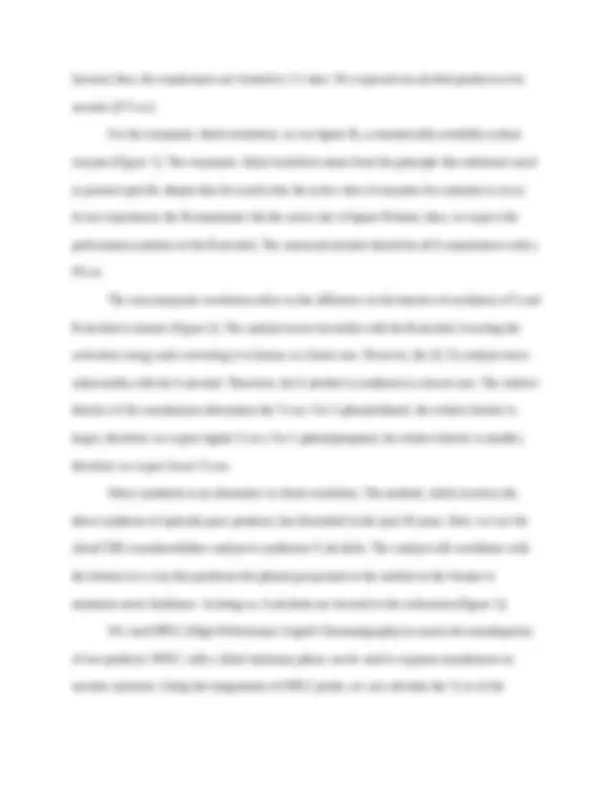
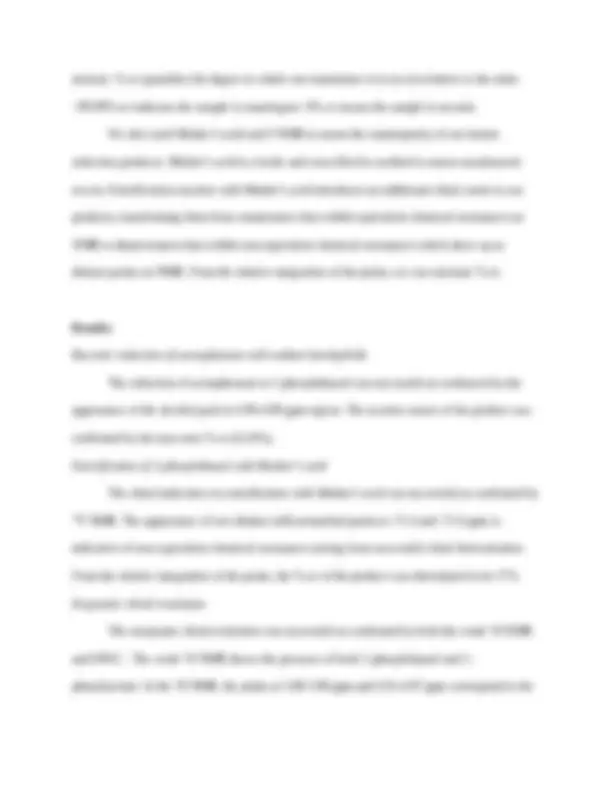
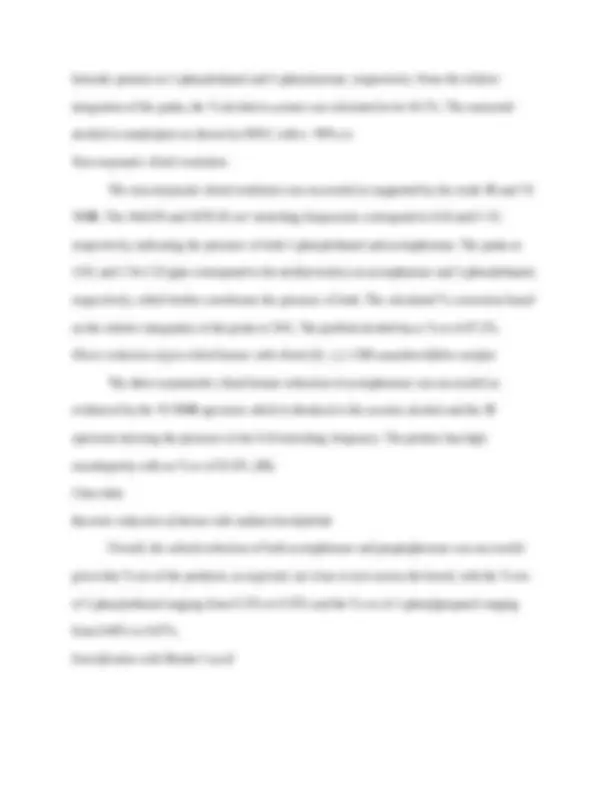
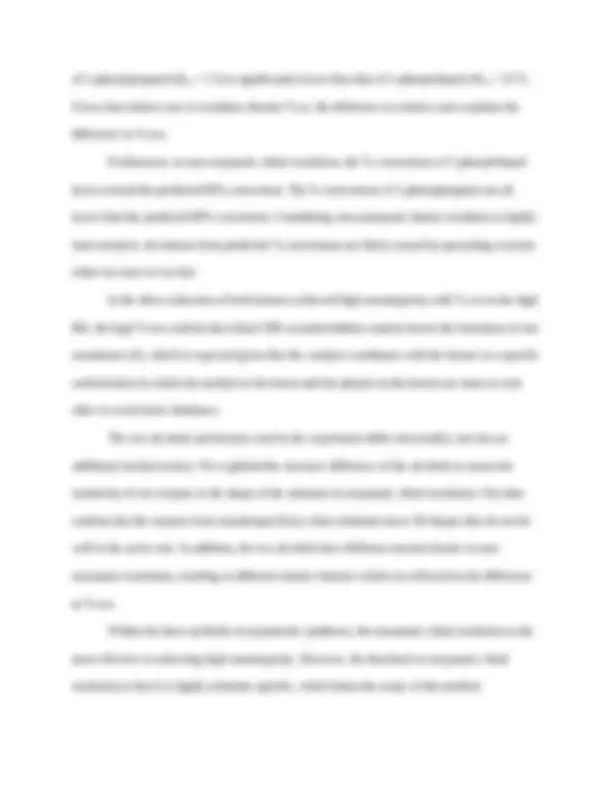
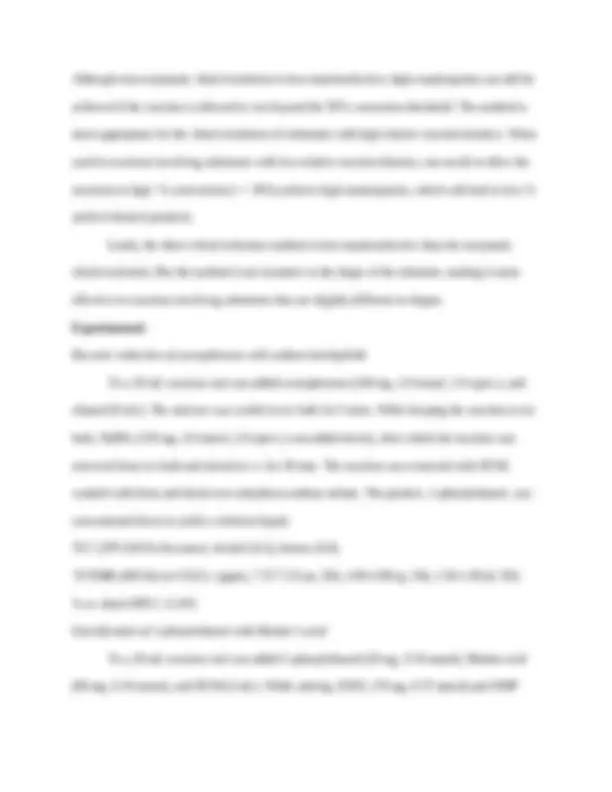
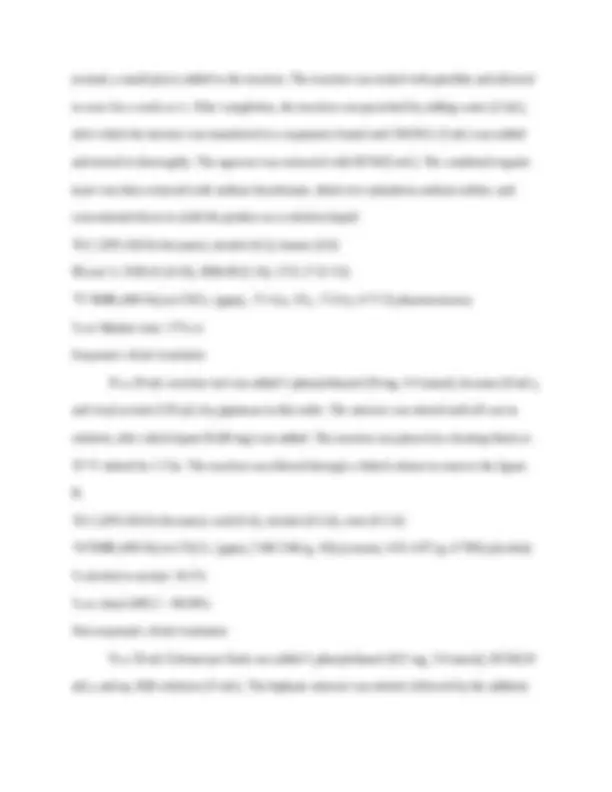
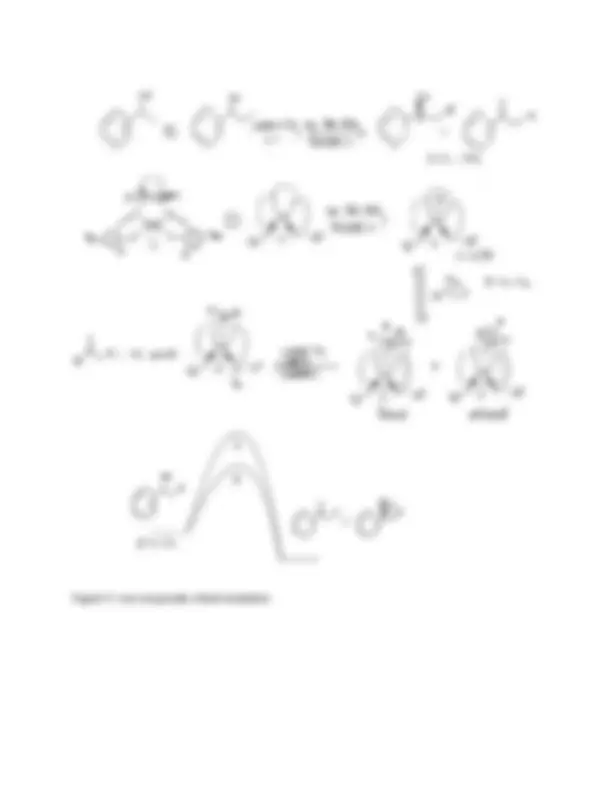
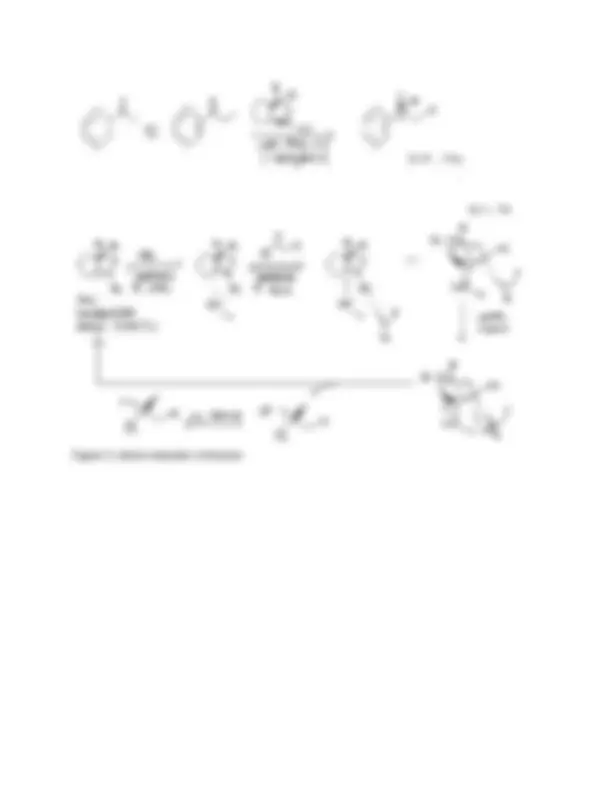


Study with the several resources on Docsity

Earn points by helping other students or get them with a premium plan


Prepare for your exams
Study with the several resources on Docsity

Earn points to download
Earn points by helping other students or get them with a premium plan
Community
Ask the community for help and clear up your study doubts
Discover the best universities in your country according to Docsity users
Free resources
Download our free guides on studying techniques, anxiety management strategies, and thesis advice from Docsity tutors
This experiment aims to perform a comparative study of three different methods of asymmetric synthesis: enzymatic chiral resolution, non-enzymatic chiral resolution, and direct chiral reduction of ketones via S-Me-CBS-catalyst on racemic mixtures of 1-phenylethanol and 1-phenylpropanol derived from the achiral reduction of acetophenone and propiophenone.
Typology: Lab Reports
1 / 14

This page cannot be seen from the preview
Don't miss anything!









Abstract: This experiment aims to perform a comparative study of three different methods of asymmetric synthesis: enzymatic chiral resolution, non-enzymatic chiral resolution, and direct chiral reduction of ketones via S-Me-CBS-catalyst on racemic mixtures of 1-phenylethanol and 1-phenylpropanol derived from the achiral reduction of acetophenone and propiophenone. We used HPLC to assess the enantioselectivity of the methods, and we used H NMR to assess % conversion. We found that enzymatic chiral resolution was the most effective method in achieving high enantiopurity (98% to >99.99% ee) for 1-phenylethanol reaction. However, the method was ineffective for the resolution of 1-phenylpropanol (8% to 15% ee), which fits poorly in the enzyme's active site. The non-enzymatic chiral resolution also achieved high enantioselectivity in the resolution of 1-phenylethnaol (87.2% to 94.12% ee). But the method could only achieve relatively low enantioselectivity (14% to 20.8%). However, the difference in enantioselectivity was expected given that the relative kinetics of two alcohols are different. The direct chiral reduction of ketones via S-Me-CBS-catalyst was able to achieve high enantioselectivity in both ketone reductions (88.3% to 87.1% ee). In addition to the three methods of asymmetric synthesis, we also used Mosher’s acid and F NMR to determine % ee of the alcohol products from the ketone reductions. However, Mosher’s acid data (17% to 26% ee) do not reflect the racemic nature of our products, which has a near-zero % ee as confirmed by HPLC. Introduction: Enantiomers are non-superimposable mirror-image structures. They have virtually identical physical properties except for the direction of polarized light. Diastereomers are non- superimposable non-mirror-image structures that possess different physical properties. Enantiomers are important to drug interactions because they behave differently in the chiral environment of the human body. Often, only one of the enantiomers exhibits therapeutic activity;
the other can induce undesirable side effects. For instance, thalidomide was a widely used racemic drug that caused congenital disabilities in pregnant women. Ensuing investigation showed that only the R-thalidomide was responsible for the birth defects. If the drug was administered in the form of L-thalidomide, the disaster could have been avoided. Thus, the ability to obtain optically pure drugs is of vital importance. Artificial methods to obtain optically pure compounds can be divided into three categories: chiral resolution, chiral pool, and direct synthesis. Chiral resolution is a well- established practice in industry. The method involves reacting a racemic mixture with chiral derivatizing agents to form a pair of diastereomers separable from each other given their distinct physical properties. Chiral resolution is an example of an enantioselective process where the formation of one enantiomer is favored over the other. In enantioselective processes, chiral auxiliaries, such as chiral derivatizing agents in the case of chiral resolution, are used to bias the formation of one enantiomer. An enantioselective process with near 100% enantioselectivity is considered enantiospecific. Enzymatic chiral resolution is expected to be enantiospecific and non-enzymatic chiral resolution is expected to be enantioselective. In this experiment, we conducted a comparative chiral resolution study involving 1- phenylethanol and 1-phenylpropanol using both enzymatic and non-enzymatic chiral auxiliaries. The racemic alcohols used in our study are produced from the non-enantioselective reduction of acetophenone and propiophenone using NaBH4, an achiral reducing agent. The process is non- enantioselective because the transition state energy of the enantiomers is equal and no pathway is
mixture. % ee quantifies the degree to which one enantiomer is in excess relative to the other.
99.99% ee indicates the sample is enantiopure. 0% ee means the sample is racemic. We also used Mosher’s acid and F NMR to assess the enantiopurity of our ketone reduction products. Mosher’s acid is a facile and cost-effective method to assess enantiomeric excess. Esterification reaction with Mosher’s acid introduces an additional chiral center to our products, transforming them from enantiomers that exhibit equivalent chemical resonances on NMR to diastereomers that exhibit non-equivalent chemical resonances which show up as distinct peaks on NMR. From the relative integration of the peaks, we can calculate % ee. Results: Racemic reduction of acetophenone with sodium borohydride The reduction of acetophenone to 1-phenylethanol was successful as evidenced by the appearance of the alcohol peak in 4.90-4.89 ppm region. The racemic nature of the product was confirmed by the near-zero % ee (0.24%). Esterification of 1-phenylethanol with Mosher’s acid The chiral induction via esterification with Mosher’s acid was successful as confirmed by (^19) F NMR. The appearance of two distinct trifluoromethyl peaks at -71.4 and -71.6 ppm is indicative of non-equivalent chemical resonances arising from successful chiral derivatization. From the relative integration of the peaks, the % ee of the product was determined to be 17%. Enzymatic chiral resolution The enzymatic chiral resolution was successful as confirmed by both the crude 1 H NMR and HPLC. The crude 1 H NMR shows the presence of both 1-phenylethanol and 1- phenylacetate. In the 1 H NMR, the peaks at 5.88-5.88 ppm and 4.91-4.87 ppm correspond to the
benzylic protons on 1-phenylethanol and 1-phenylacetate, respectively. From the relative integration of the peaks, the % alcohol to acetate was calculated to be 44.1%. The unreacted alcohol is enantiopure as shown by HPLC with a >99% ee. Non-enzymatic chiral resolution The non-enzymatic chiral resolution was successful as supported by the crude IR and 1 H NMR. The 3444.95 and 1678.18 cm-1^ stretching frequencies correspond to O-H and C=O, respectively, indicating the presence of both 1-phenylethanol and acetophenone. The peaks at 2.63, and 1.54-1.52 ppm correspond to the methyl moiety on acetophenone and 1-phenylethanol, respectively, which further corroborate the presence of both. The calculated % conversion based on the relative integration of the peaks is 54%. The purified alcohol has a % ee of 87.2%. Direct reduction of pro-chiral ketone with chiral (S) - (-) -CBS-oxazaborolidine catalyst The direct asymmetric chiral borane reduction of acetophenone was successful as evidenced by the 1 H NMR spectrum which is identical to the racemic alcohol and the IR spectrum showing the presence of the O-H stretching frequency. The product has high enantiopurity with an % ee of 91.0%. (IR) Class data Racemic reduction of ketone with sodium borohydride Overall, the achiral reduction of both acetophenone and propiophenone was successful given that % ees of the products, as expected, are close to zero across the board, with the % ees of 1-phenylethanol ranging from 0.13% to 0.33% and the % ees of 1-phenylpropanol ranging from 0.06% to 0.67%. Esterification with Mosher’s acid
difference in the % ees of 1-phenylethanol and 1-phenylpropanol products. Both Mosher’s acid chiral induction and direct reduction of pro-chiral ketone are not sensitive to the shape of the reactant as there is no significant difference in the % ee of two alcohols. Discussion/Conclusion: In this experiment, we conducted a comparative study of different methods of asymmetric synthesis. We found that enzymatic chiral resolution was the most effective method to achieve enantiopurity. Mosher’s acid data do not show the mixtures to be racemic. We believe that is caused by incomplete esterification, which is confirmed by the residual O-H stretching frequencies in the IR spectrum. As expected, enzymatic chiral resolution was extremely sensitive to the shape of the substrate. This was reflected in % ees of the two alcohols. The % ees of 1-phenylethanol ranging from 98% to >99.99% indicate that the enzyme is enantiospecific. However, in the case of 1- phenylpropanol, the addition of a methyl moiety led to a drastic drop in the % ees of the alcohol (9.42% to 15%). It is worth noting that there is no significant difference in the % conversion from alcohol to acetate for both alcohols, indicating that the additional methyl moiety did not affect reaction kinetic. We therefore conclude that the additional methyl moiety hindered the enzyme’s ability to recognize the correct chiral substrate resulting in poor chiral resolution. This further confirms that the enantioselectivity of the enzyme is highly dependent on the fit of the substrate in the active site. The non-enzymatic chiral resolution is enantioselective. As predicted by the relative rate of oxidation of each enantiomer, the % ees of 1-phenylethanol are about 90% and those of 1- phenylpropanol hover around 15%. We expected the % ee of 1-phenylpropanol to be significantly lower than that of 1-phenylethanol because the relative rate of oxidation to ketone
of 1-phenylpropanol (Krel = 1.5) is significantly lower than that of 1-phenylethanol (Krel = 13.7). Given that relative rate of oxidation dictates % ee, the difference in relative rates explains the difference in % ees. Furthermore, in non-enzymatic chiral resolution, the % conversions of 1-phenylethanol hover around the predicted 60% conversion. The % conversions of 1-phenylpropanol are all lower than the predicted 60% conversion. Considering non-enzymatic kinetic oxidation is highly time-sensitive, deviations from predicted % conversions are likely caused by quenching reaction either too soon or too late. In the direct reduction of both ketones achieved high enantiopurity with % ees in the high 80s. the high % ees confirm that chiral CBS-oxazaborolidine catalyst favors the formation of one enantiomer (S), which is expected given that the catalyst coordinates with the ketone in a specific conformation in which the methyl on the boron and the phenyl on the ketone are trans to each other to avoid steric hindrance. The two alcohols and ketones used in the experiment differ structurally; one has an additional methyl moiety. We exploited the structure difference of the alcohols to assess the sensitivity of our enzyme to the shape of the substrate in enzymatic chiral resolution. Our data confirm that the enzyme loses enantiospecificity when substrates have 3D shapes that do not fit well in the active site. In addition, the two alcohols have different reaction kinetic in non- enzymatic resolution, resulting in different relative kinetics which are reflected in the difference in % ees. Within the three methods of asymmetric syntheses, the enzymatic chiral resolution is the most effective in achieving high enantiopurity. However, the drawback to enzymatic chiral resolution is that it is highly substrate-specific, which limits the scope of this method.
(crystal, a small piece) added to the reaction. The reaction was sealed with parafilm and allowed to react for a week at r.t. After completion, the reaction was quenched by adding water (2 mL), after which the mixture was transferred to a separatory funnel and 1M HCL (5 mL) was added and mixed in thoroughly. The aqueous was extracted with DCM (5 mL). The combined organic layer was then extracted with sodium bicarbonate, dried over anhydrous sodium sulfate, and concentrated down to yield the product as a colorless liquid. TLC (50% EtOAc/hexanes): alcohol (0.2), ketone (0.6) IR (cm-1): 3339.41 (O-H), 2968.08 (C-H), 1721.17 (C=O) (^19) F NMR (400 Hz) in CDCl 3 : (ppm), -71.4 (s, 1F), -71.6 (s, 0.71 F) (diastereomers) % ee Mosher ester: 17% ee Enzymatic chiral resolution To a 20 mL reaction vial was added 1-phenylethanol (50 mg, 0.4 mmol), hexanes (8 mL), and vinyl acetate (150 μL) by pipetman in this order. The mixture was stirred until all was in solution, after which lipase B (80 mg) was added. The reaction was placed in a heating block at 35 °C stirred for 1.5 hr. The reaction was filtered through a fritted column to remove the lipase B. TLC (20% EtOAc/hexanes): acid (0 rf), alcohol (0.3 rf), ester (0.5 rf) (^1) H NMR (400 Hz) in CD 2 Cl 2 : (ppm), 5.88-5.88 (q, 1H) (acetate), 4.91-4.87 (q, 0.79H) (alcohol) % alcohol to acetate: 44.1% % ee chiral HPLC: >99.99% Non-enzymatic chiral resolution To a 50 mL Erlenmeyer flask was added 1-phenylethanol (611 mg, 5.0 mmol), DCM ( mL), and aq. KBr solution (15 mL). The biphasic mixture was stirred, followed by the addition
of catalyst I (65 mg, 0.10 mmol). The mixture was stirred further for 5 mins, after which PhI(OAc) 2 (0.966 g, 3.0 mmol) was added and the reaction was allowed to proceed at r.t. for 15 mins. The reaction was quenched with saturated sodium thiosulfate (20 mL). The mixture was then transferred to a separatory funnel, and the flask was rinsed with DCM (10 mL) to ensure maximal transfer. Afterward, the aqueous layer was extracted with DCM (20 mL) two times. The combined organic layer was extracted with equal volume brine, dried over anhydrous sodium sulfate, and concentrated down to yield the crude mixture was a colorless liquid. The crude was purified via silica chromatography. The alcohol product was eluted in 30% EtOAc/hexanes. The concentrated product was a colorless liquid. TLC (20% EtOAc/hexanes): alcohol (0.3 rf), ketone (0.5 rf) IR (cm-1): 3444.95 (O-H), 2975.90 (C-H), 1678.18 (C=O) (^1) H NMR (400 Hz) in CD 2 Cl 2 : (ppm), 2.63 (s, 1H) (ketone), 1.54-1.52 (d, 0.85H) (alcohol) % reaction conversion to ketone: 54% Purified product (^1) H NMR: identical to racemic alcohol % ee chiral HPLC: 87.2% Direct reduction of pro-chiral ketone with chiral (S) - (-) -CBS-oxazaborolidine catalyst The reaction was conducted under nitrogen flow. To a 20 mL reaction vial was added chiral catalyst (0.10 mL, 0.05 mmol) and borane-N,N-diethyaniline complex (1.2 mL, 1. mmol). Afterward, ketone solution (2.0 mL, 1.0 mmol) was added dropwise. The reaction was stirred at r.t. for 1 hr. The reaction was quenched by dropwise addition of methanol (1 mL). 1M HCl (5mL) was added to the quenched reaction and allowed to stir for 15 min at r.t. The reaction mixture was transferred to a separatory funnel. The aqueous layer was extracted with diethyl
Figure 2: non-enzymatic chiral resolution
Figure 3: direct reduction of ketone